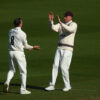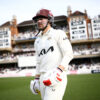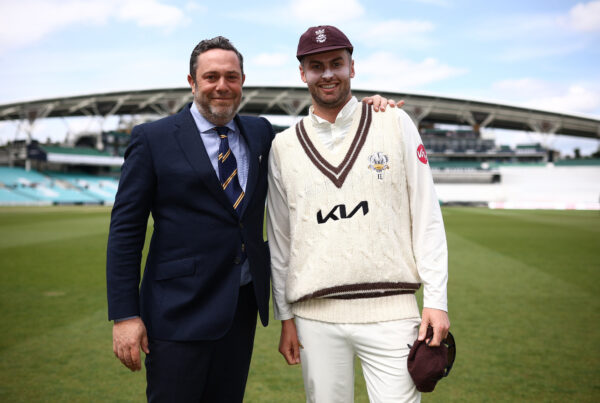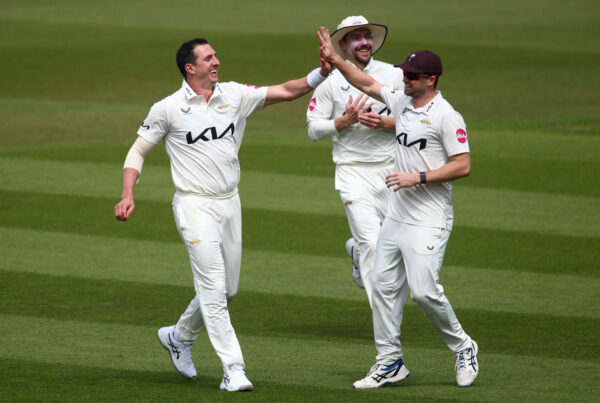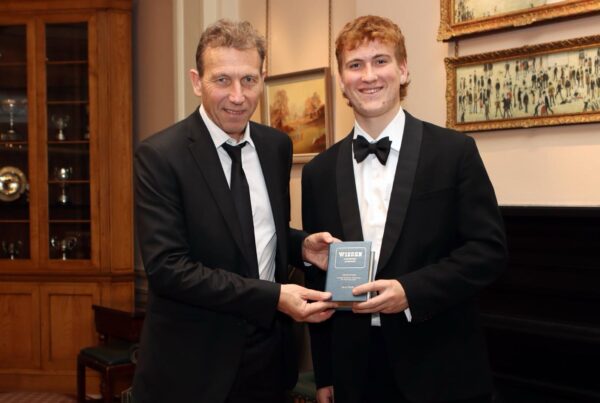It was 70 years ago that Surrey embarked on a season they hoped would bring them a hat-trick of County Championship titles. Richard Spiller spotlights what happened in 1954
The wettest summer since 1903 threatened to be a damp squib for Surrey in more ways than one.
Outright champions in 1952 – for the first time since 1914, although they shared the title with Lancashire in 1950 – Stuart Surridge’s side had seen off a concerted challenge from Sussex to remain at the summit the following summer. It was achieved despite contributing generously to England’s recovery of the Ashes.
Yet their form in the opening three months of the campaign was patchy, winning just six and losing three of the opening 16 matches. With July all but over, they stood eighth in the table and trailed leaders Yorkshire – who had played two more games – by a worrying 46 points.
The prospects of becoming the first team to claim a hat-trick for 15 years looked remote when Surrey took the field against Essex at The Oval.
But the dynamism which was Surridge’s hallmark was switched on at full strength. Both Essex and Nottinghamshire were beaten by 10 wickets before a nervy win by one wicket over Northamptonshire at Kettering, where off-spinner Jim Laker – largely ignored by the England selectors since touring West Indies in the winter – took 10 wickets and then made 33no as Surrey just chased down 138.
Rain wrecked the derby with Middlesex but Surrey at least claimed four points by making 193-5dec and then dismissing the visitors for 51.

Although still a long way off the pace, Surrey were now in prime form and swallowing up opponents greedily. They beat Leicestershire (six wickets), Gloucestershire (156 runs), Worcestershire (10 wickets), Middlesex again (innings and 19 runs) before Worcestershire arrived at The Oval in the final week of August for a match where victory would secure the title again.
Play could not start until 2pm on the first day, Surridge inserting the visitors on a rain-affected pitch and seeing his attack demolish them for 25 in just 100 minutes through left-arm spinner Tony Lock (5-2), Laker (2-5) and Alec Bedser (2-12) took typical advantage of helpful conditions.
Surrey’s reply was moving along nicely at 92-3 – Peter May in command on 31 – when Surridge dramatically declared with an hour of play remaining. Those players who had occasionally doubted their captain’s sanity had their fears confirmed but they claimed two wickets before the close. And the following morning it took just an hour to rout the rest, Bedser (3-7) and Laker (4-25) this time leading the way and Lock’s 1-3 leaving him with enviable match figures.
Champions again – topping off their triumph by overcoming Lancashire by 93 runs – Surrey’s nine victories from their final 10 games earned them 112 points from the 120 points available, leaving Norrman Yardley’s Yorkshire side adrift in second place by 22.
It would prove only to be the third chapter of Surrey’s unprecedented run of seven successive Championships, five under Surridge followed by two under May.
While it was the bowlers on whom the spotlight fell, they still required the ammunition of runs. Tom Clark (1,372 at 40) and Bernie Constable (1,003 at 28) – the only two players ever-present – led the way while May’s 18 appearances yielded 947 at 49. The retirements of Laurie Fishlock and Jack Parker after the 1952 season had left gaps and they were now being filled by Ken Barrington (715 at 37) and Micky Stewart, who made his maiden first-class century in the tour match against Pakistan.
England ignoring Laker for all but one Test and Lock for the whole series proved a boon for their county, claiming 101 wickets at 13 and 112 at 14 respectively. Bedser’s command of seam and swing, yielding 89 scalps at 13, was augmented by the pace of Peter Loader, whose 73 at 14 earned him a Test debut at The Oval and a place on the following winter’s Ashes tour. Surridge’s 38 wickets were added to his 31 catches close to the wicket, Lock exceeding that with 35. The lethal close field also featured Laker (25) and Stewart (26), all built around wicketkeeper Arthur McIntyre, whose 33 catches were joined by nine stumpings.
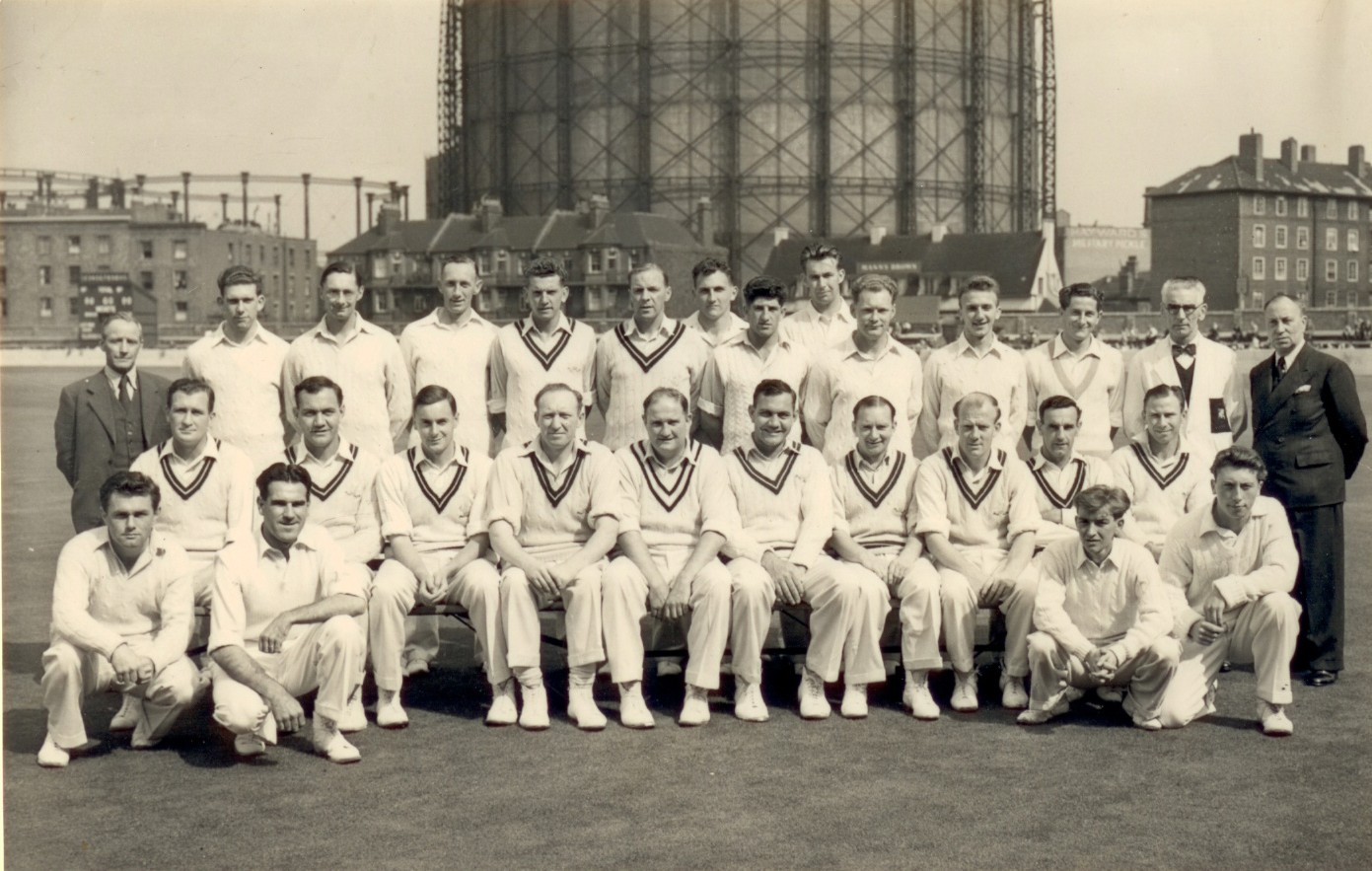
OVAL TEST
Just a year earlier Len Hutton had gazed out from the dressing room balcony at the adoring crowd, jubilant that England had finally won back the Ashes after 19 years.
Now England’s captain would find himself on the wrong end of history this time against international new boys Pakistan. He had been forced to miss the previous two Tests, the mental and physical strain of hauling his side back from 2-0 down to draw 2-2 in an acrimonious tour of West Indies, forcing him to take a break from cricket.
Hutton had been in charge when rain deprived England of victory at Lord’s, David Sheppard taking over for an innings success at Trent Bridge and then another heavily interrupted draw at Old Trafford which saved the tourists from conceding the series.
With a tour of Australia pending, England took the liberty of fielding an understrength side, which meant a rest for all-rounder Trevor Bailey and attack leader Alec Bedser, the latter replaced by Surrey colleague Peter Loader – making his debut – alongside fellow paceman Frank Tyson.
Not that it seemed to matter when Pakistan plunged to 51-7 after a delayed start on day one, Tyson showing the pace which would prove so crucial the following winter.
Skipper Abdul Hafeez Kardar (36) and useful contributions from the tail dragged Pakistan up to 133, England 1-0 from two overs overnight and having to wait until day three after a massive cloudburst flooded the ground. A rain-affected pitch made their reply all the harder against Fazal Mahmood and Mahmood Hussain. Denis Compton’s attacking approach had the most success – helped by being dropped twice – in making 53 but the next best was Peter May’s 26. Paceman Hussain claimed 4-58 but more effective was medium-pacer Fazal – similar to the absent Bailey and Bedser – who collected 6-53 from his 30 overs as England slumped to 130 all out.
Attempting to build on an unlikely lead, however slender, Pakistan were back in trouble at 82-8, their principal torturer Johnny Wardle as he claimed 7-56. The Yorkshire left-arm spinner had been preferred all summer to Surrey’s Tony Lock and although Glamorgan off-spinner Jim McConnon – preferred to Jim Laker – was unable to offer much support he would still earn a winter tour spot.
Wazir Mohammad (42no) and Zulfiqar Ahmed (34) effected a rescue this time but England went back in on day four needing 168 to wrap up the series. At 109-2 they looked certainties to achieve it, even pushing wicketkeeper Godfrey Evans up the order in an apparent to finish the match with a day to spare. It rebounded on them horribly, slumping to 125-6 overnight and a weak tail were scattered the next morning. Fazal had already claimed 12 wickets in his country’s maiden Test win – over India at Lucknow – and now repeated the trick, his 6-46 seeing the hosts defeated by 24 runs for their first victory in England and a share of the series.
There was all the more joy for Pakistan, who had felt patronised for much of the summer but now shown the fighting qualities which have distinguished their play in becoming the first team to win a Test on their maiden tour of England.

WHAT ELSE HAPPENED IN 1954?
One of the final vestiges of the Second World War, food rationing, was finally ended in the United Kingdom when restrictions on the sale of meat were abolished. Availability of cheese was still patchy for several years after that and it was not until 1958 that coal rationing was abolished.
The first successful kidney transplant was completed.
Roger Bannister, who combined practising as a junior doctor with middle distance running, became the first person to run a mile in less than four minutes. Helped by Christopher Chataway and Chris Brasher setting the pace at the Iffley Road track in Oxford, he completed it in 3min 59.4sec.
Wolverhampton Wanderers won the Football League Championship for the first time in their history, finishing four points ahead of midlands rivals West Bromwich Albion, who compensated by overcoming Preston North End 3-2 in the FA Cup final.
The World Cup, which followed the season, saw England finish top of their group – drawing 4-4 with Belgium and beating hosts Switzerland 2-0 – before losing 4-2 against defending champions Uruguay in the quarter-finals. Scotland failed to advance beyond the group stages. West Germany beat Hungary in the final, which was dubbed the “miracle of Bern”.
At Wimbledon, Czech exile Jaroslav Drobny won the men’s singles, beating Australia’s Ken Rosewall 13-11 4-6 6-2 9-7. Maureen Connolly defeated fellow American Louise Brough 6-2 7-5 for the women’s title.
Wales, England and France shared rugby union’s Five Nations Championship, each winning three out of four matches – having taken the Triple Crown and Calcutta Cup, England were on course for a grand slam only to be beaten 11-3 by France in Paris.
Great Britain won the inaugural Rugby League World Cup, defeating France in the final in Paris.
Australia’s Peter Thomson won the first of five Open Championship titles, finishing one shot ahead of Bobby Locke, Dai Rees and Syd Scott at Royal Birkdale.
Juan Fangio won the Formula One driver’s championship, the only man to do so representing two teams (Maserati and Mercedes-Benz) in the same season. Briton Mike Hawthorn was third.
